Abstract
According to the reports published in the paper
Keywords: Special educational needschildrenspinedeficiency
Introduction
The phrase “Special Educational Needs” (SEN) means additional educational requirements, complementary to the general educational objectives adapted to individual peculiarities. Although this term seems ambiguous, it is a relevant form in the psycho-pedagogical plane, because it clearly aims at individualising evaluation and the educational approach. In this respect, SEN involves complex assistance, including medical, social and educational aspects.
Alois Gherguţ (2005) states that "the medical aspect - the deficiency - refers to the deficit established by the clinical and paraclinical methods and means, by the functional explorations or other assessments used by medical services, deficit that can be physical, mental, sensorial, locomotor, neuropsychological or by language."
Children with special educational needs are those whose requirements mainly derive from the mental, physical, sensory, language, emotional and behavioural deficiencies or are associated with, regardless of their severity.
Under the current conditions, when trying to integrate as many children with special educational needs from special education into mass education, multi- and interdisciplinary teams work for them to achieve the best results.
Problem Statement
The chosen theme is of real interest, given the complexity of the term “educational needs/special education” and the importance of acquiring/maintaining a correct posture of the body that can be affected by various temporary or permanent physical or psycho-sensory dysfunctions determining states of infirmity, disability, handicap or invalidity.
The posture, as it is defined by Cordun (1999a), is a function of the human body based on the synergic and coordinated action of the elements of the locomotor system and of the central and peripheral nervous system through which it is maintained: stability of the body, equilibrium and constant relations between the segments of the body as well as between the body and the environment surrounding".
Kinesiotherapy, together with other therapeutic, recovery and re-education subjects, contributes to increasing the degree of adaptability and normality by correcting, ameliorating and/or compensating for the deficiencies of the musculoskeletal system.
In this paper, we focused our attention on the body posture of these children, posture which is grafted on the types of deficiencies mentioned above, more precisely on the deficiencies existing in the spine. Thus, we tried, through a complex evaluation, to highlight the incidence of the spine deficiencies, classifying these deficiencies according to their form, the age and gender of the patients, so that to have in the end a well-structured database, which may later serve for different purposes. Equally important, we believe that this database will be extremely beneficial in monitoring the somatic-functional development of these children, their personal autonomy and social inclusion.
Research Questions
In our research, we intend to verify if, in the conditions of preparation and application of a well-structured assessment protocol, the results on the incidence of the spine deficiencies in children with special educational needs or mental disabilities highlight a concrete reality on these issues. The results can provide a real database that can be used later for various purposes.
Purpose of the Study
Starting from the importance of maintaining a correct body posture, which can be affected by various temporary or permanent physical or psycho-sensory dysfunctions, we propose in this paper to identify the deficiencies of the spine in children with mental deficiency.
The aim of the paper is to create a database on the incidence of the spine deficiencies in children with special educational needs or children with mental deficiency.
Research Methods
In our scientific approach, we used the following research methods: study of the bibliographic material, pedagogical observation, measurement and evaluation, statistical processing, graphical representation.
We propose an observant-type research - " which aims at knowing and describing thoroughly an aspect, a process", meeting the qualitative aspect of a research design, which together with the quantitative one make the research complete and credible” (Niculescu, 2003).
The research design contains:
the period and location of the research;
the research sample;
the research logistics, of which: general somatoscopic examination, instrumental somatoscopic examination, recording of the results in the evaluation file.
The period and location of the research
This research was conducted during the school year 2016-2017. The evaluation and recording took place over a period of 3 months, namely from September to November 2016, followed by the processing and interpretation of the results. The location of the research was represented by the gymnastics room in the “Constantin Păunescu” Special Middle School, which was equipped with all the appropriate and necessary materials for our scientific approach.
The research sample
In order to perform an effective measurement and evaluation, necessary for our scientific substantiation, we worked with a sample of 150 subjects, 49 girls and 101 boys, pupils in grades 0-8 at the “Constantin Păunescu” Special School, aged between 7 and 22 years, with moderate to severe mental deficiency.
For the purpose of a more eloquent graphical illustration, we considered it useful to divide the research sample into age categories (Epuran & Horghidan, 2005), as follows:
Small school age: 7 - 10/11 years
Middle school age (preadolescence / puberty): 10/12 - 14/15 years
High school age (adolescence): 15-18 years
Age of youth: 18/19 - 25 years.
We mention that pupils schooled at home and those with neuromotor problems have not been evaluated and therefore have not been included in the research.
The research logistics
To determine the incidence of the spine deficiencies in children with mental deficiency through a detailed evaluation consisting of general somatoscopic examination and instrumental somatoscopic examination, respectively with the anthropometric symmetry framework, we started by designing this instrument indispensable for an objective assessment.
Thus, we made the anthropometric frame of symmetry (AFS) according to the parameters in the literature (Cordun, 1999b): dimensions: 2 m high and 1 m wide. Grading was performed horizontally from the middle, from the zero point (0) to the right and to the left, from 10 to 10 cm, and vertically from the bottom upwards, from 0 to 200 cm. Thus, the anthropometric symmetry frame is divided into squares with sides of 10 cm. The middle vertical from the zero points (00) overlaps the median line of the body.
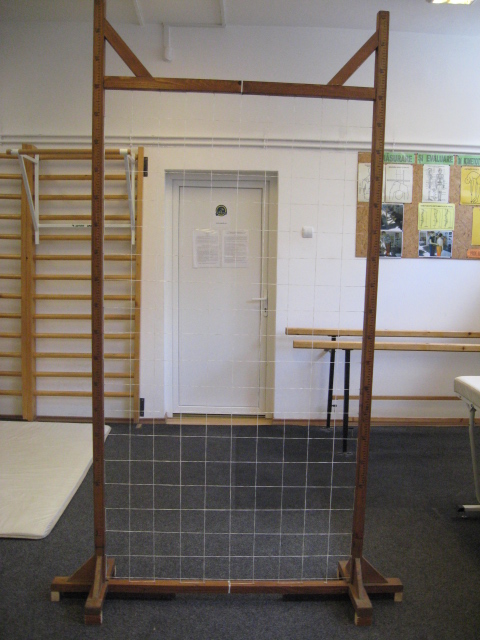
After this stage, the evaluation file was drawn up, which required laborious work, so as to obtain objective results and establish a functional diagnosis necessary for our scientific approach.
We also studied and analysed the children’s files that provided us with important information about the diagnosis of mental deficiency, the disability, personal data, the form of protection and various observations, which, together with our assessment in this research, we hope to have led to an overall picture of each child, thus facilitating the future monitoring of their growth and development, socialisation and, last but not least, their subsequent integration as much as possible.
The instrumental somatoscopic examination was performed, as it is stated in the literature, from the back, face and profile.
The front and back examinations provided information on the specificities of the deficiencies occurring in the frontal plane, respectively the scoliosis, and the examination in profile revealed the specific aspects and defining characteristics for the deviations of the spine in the sagittal plane, namely the kyphosis, lordosis and their combinations.
Findings
Incidence of the spine deficiencies in children with mental deficiency
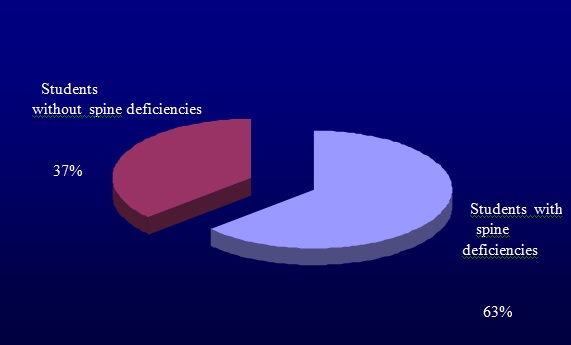
From the graph above, it is noted that out of the total of students evaluated in the research, 63% have deficiencies in the spine and only 37% do not have any spine deficiency. We mention that of the total number of students with spine deficiencies, 67.37% are boys and 32.63% are girls.
Classification of the spine deficiencies according to frontal or sagittal deviations, respectively in scoliosis, kyphosis or lordosis and/or combinations thereof
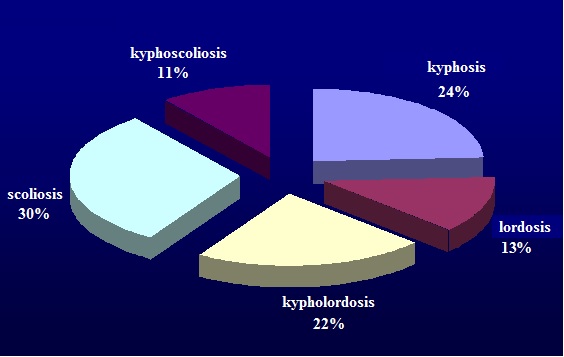
By making a taxonomy of the spine deficiencies found in our research, it can be seen from the graph above that the first, with a percentage of 30% of the total deficiencies of the spine, are the deviations in the frontal plane, respectively the scoliosis, followed, with a percentage of 24%, by the deviations in the sagittal plane, respectively the kyphosis, and on the third place, the kypholordosis, in a percentage of 22%. The lordosis accounts for 13%, and the kyphoscoliosis for only 11%.
The situation of the spine deficiencies by age category
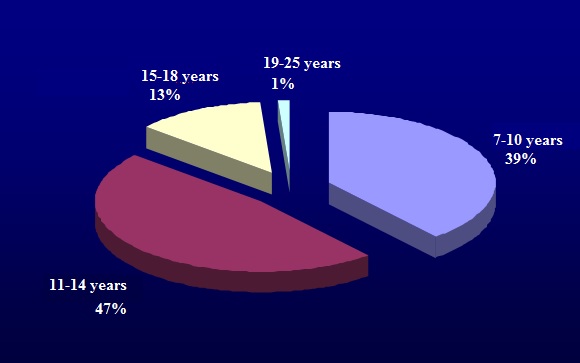
From the graph above, it is noted that, on the first place, representing 47% of all pupils with physical deficiencies in the spine, is the middle school age (puberty). On the second place, with a percentage of 39%, is the low school age, and the third (13%) place is occupied by the high school age (adolescence). A very small percentage, 1%, is represented by the age group 19-25 years (age of youth).
Distribution of the spine deficiencies in boys
The distribution of the spine deficiencies in boys (Figure
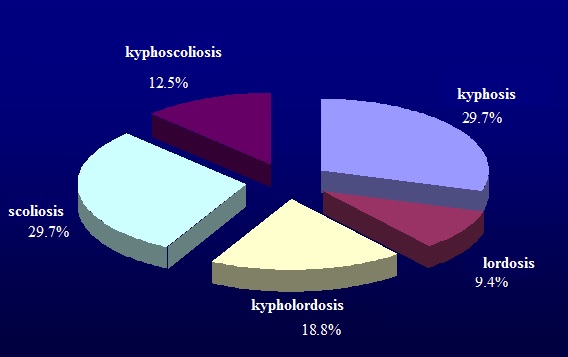
6.5. Distribution of the spine deficiencies in girls
The deviation of the spine in the frontal plane, respectively the scoliosis, is placed on the first place in girls, with 35.5%, followed by the kypholordosis, 29%, and then the deficiencies in the sagittal plane, the kyphosis and lordosis to equality, 16.1%, and on the last place, with only 3.2%, kyphoscoliosis.
Conclusion
The conclusions drawn from the processing and interpretation of the obtained results reflect the real situation of the presence of the spine deficiencies in children with mental deficiency, without claiming to be fully representative for the target population.
Theoretical Conclusion
-
The issue of children with special educational needs, both as regards the individual and the society, is a theme that occupies an increasingly important place in the contemporary society. Children with special educational needs require complex assistance, including medical, social and educational aspects.
-
Therefore, due to the complexity of the term “special educational needs”, under the current conditions, multi- and interdisciplinary teams work with these children in order to create their personal, socio-professional autonomy as much as possible.
-
The body posture of these children is often affected by temporary or permanent mental, psycho-sensory, physical dysfunctions etc., and because their treatment is inappropriate and not applied in due time, they lead to infirmity, disability, invalidity.
-
The support of kinesiotherapy, along with other therapeutic subjects, is major, contributing to the increase in the degree of adaptability and normality by correcting, ameliorating and/or compensating for the deficiencies of the musculoskeletal system. But without an objective and specialized assessment of the body posture, the therapeutic valences of the activities undertaken are largely cancelled.
-
A real database on the incidence of the spine deficiencies, their form, the age and gender of the patients will help to determine the main directions of the rehabilitation activities needed for the best somatic-functional development, personal autonomy and social integration.
Conclusions of the research
-
The analysis of the research results shows that more than half of the mentally deficient pupils (63%) have physical deficiencies in the spine and only for 37% of them their presence has not been found.
-
From the total spine deficiencies, there was a higher incidence of the deviations in the frontal plane, respectively the scoliosis, followed by the deviations in the sagittal plane, respectively the kyphosis. In a smaller percentage, there were the kypholordosis, lordosis and kyphoscoliosis.
-
The middle school age category (puberty) is the most affected by the presence of the spine deficiencies, followed by the low school age category, which is quite worrying. In boys, the deficiencies in the form of kyphosis and scoliosis also predominate, while in girls, the scoliosis dominates the picture of the spine deficiencies.
-
The evaluation file has led to objective results, which constitutes a real database of the situation of the spine deficiencies, which leads to the confirmation of our hypothesis.
-
As we have seen, the large number of pupils with spine deficiencies, as well as of those with neuromotor disorders, who, although not included in the research sample, are in a quite large number and should also benefit from kinesiotherapy lessons, sadly reveals that the small number of hours allocated to physical therapy in the curriculum can only cover and satisfy to a limited extent the needs of these children.
References
- Cordun, M. (1999a). Kinetologie medicală. Bucureşti: Axa.
- Cordun, M. (1999b). Postura corporală normală şi patologică. Bucureşti: ANEFS
- Epuran, M., & Horghidan, V. (2005). Psihologia educației fizice. Bucureşti: ANEFS
- Gherguț, A. (2005). Sinteze de psihopedagogie specială, Editura POLIROM
- Niculescu, M., (2003). Metodologia cercetării ştiinţifice în educaţie fizică şi sport, volumele I, II, Bucureşti: Editura Bren.
Copyright information

This work is licensed under a Creative Commons Attribution-NonCommercial-NoDerivatives 4.0 International License.
About this article
Publication Date
05 March 2018
Article Doi
eBook ISBN
978-1-80296-035-8
Publisher
Future Academy
Volume
36
Print ISBN (optional)
-
Edition Number
1st Edition
Pages
1-484
Subjects
Sports, sport science, physical education, health psychology
Cite this article as:
Gulap, M., Andrei, A., Tătaru, T., & Șuță, V. E. (2018). The Incidence of the Spine Deficiencies in Children with Special Educational Needs. In V. Grigore, M. Stanescu, & M. Paunescu (Eds.), Physical Education, Sport and Kinetotherapy - ICPESK 2017, vol 36. European Proceedings of Social and Behavioural Sciences (pp. 359-366). Future Academy. https://doi.org/10.15405/epsbs.2018.03.48

